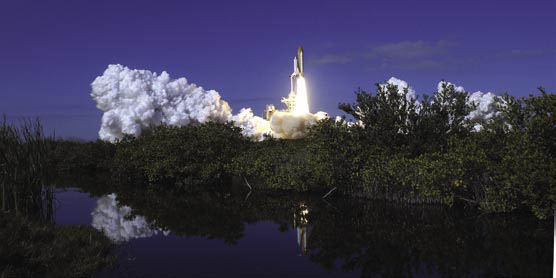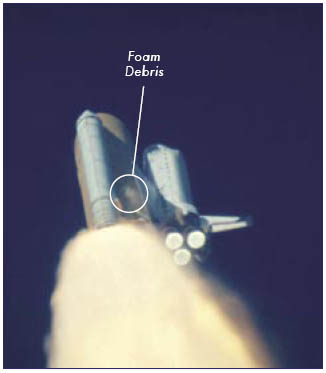2.3 LAUNCH SEQUENCE
2.3 Launch Sequence
― 打上げシークエンス ―
― 打上げシークエンス ―
The STS-107 launch countdown was scheduled to be about 24 hours longer than usual, primarily because of the extra time required to load cryogens for generating electricity and water into the Extended Duration Orbiter pallet, and for final stowage of plants, insects, and other unique science payloads. SPACEHAB stowage activities were about 90 minutes behind schedule, but the overall launch countdown was back on schedule when the communication system check was completed at L-24 hours.
STS-107の打上げに向けたカウントダウンは通常より24時間早く始められました。主な理由は、電気と水を作り出すための冷媒をオービター航続距離延長パレットに積み込むための時間が必要だったのと、植物や昆虫などのユニークな科学実験用の積荷を積み込むためでした。SPACEHABへの積み込みに90分の遅れが出ましたが、L-24時間に通信システムのチェックが終了した時点で、全てのカウントダウンがスケジュール通りに戻りました。
At 7 hours and 20 minutes prior to the scheduled launch on January 16, 2003, ground crews began filling the External Tank with over 1,500,000 pounds of cryogenic propellants. At about 6:15 a.m., the Final Inspection Team began its visual and photographic check of the launch pad and vehicle. Frost had been noted during earlier inspections, but it had dissipated by 7:15 a.m., when the Ice Team completed its inspection.
2003年1月16日の打ち上げ予定時間に先立つこと7時間20分、地上クルーは外部燃料タンクに1,500,000ポンドの低温の燃料を充填し始めました。6:15AM頃には、最終点検チームが発射台と機体の目視と写真によるチェックを開始しました。点検の初期段階では霜が観察されましたが、着氷点検チーム(Ice Team)が点検を終了した7:15AMには消えました。
Heavy rain had fallen on Kennedy Space Center while the Shuttle stack was on the pad. The launchday weather was 65 degrees Fahrenheit with 68 percent relative humidity, dew point 59 degrees, calm winds, scattered clouds at 4,000 feet, and visibility of seven statute miles. The fore-cast weather for Kennedy Space Center and the Transoceanic Abort Landing sites in Spain and Morocco was within launch criteria limits.
シャトルが発射台上にある時に、ケネディスペースセンターに激しい雨が降りました。打上げ当日の天候は、気温が摂氏18度、相対湿度68%、露点華氏15度。穏やかな風が吹き、高度4,000フィードにまばらに雲が出ていました。また、視界は7法定マイルありました。ケネディ宇宙センターと太平洋の彼方の緊急着陸地であるスペインとモロッコの天候は打上げ基準を満たしていました。
At about 7:30 a.m. the crew was driven from their quarters in the Kennedy Space Center Industrial Area to Launch Complex 39-A. Commander Rick Husband was the first crew member to enter Columbia, at the 195-foot level of the launch tower at 7:53 a.m. Mission Specialist Kalpana Chawla was the last to enter, at 8:45 a.m. The hatch was closed and locked at 9:17 a.m.
7:30AM頃までに、乗員はケネディ宇宙センターの工業エリアにある宿舎から39-A発射台に移動しました。機長のリックハズバンドが最初に打上げ塔の地上195フィートの高さからコロンビアに乗り込んだのは7:53AM。ミッションスペシャリストのカルパナ・チャウラが最後に乗り込んだのは8:45でした。そして、9:17AMにはハッチが閉じられ、ロックされました。
The countdown clock executed the planned hold at the T-20 minute-mark at 10:10 a.m. The primary ascent computer software was switched over to the launch-ready configura-tion, communications checks were completed with all crew members, and all non-essential personnel were cleared from the launch area at 10:16 a.m. Fifteen minutes later the count-down clock came out of the planned hold at the T-9 minutes, and at 10:35 a.m., the GO was given for Auxiliary Power Unit start. STS-107 began at 10:39 a.m. with ignition of the Solid Rocket Boosters (see Figure 2.3-1).
カウントダウンクロックは予定通りT-20分ちょうど、10:10AMに一旦止められました。上昇用主コンピューターのソフトウエアが打上げ準備状態に移行、乗員全員の無線のチェックが終わり、主要業務についていない職員の退去が終了したのが10:16AM。15分後には再びカウントダウンクロックがT-9分から再開され、10:35AMには補助電源ユニットのスタートにGOサインが出されました。そして、10:39AM、固体燃料ロケットブースターの点火と共にSTS-107が始まりました(図2-3-1)。

Figure 2.3-1. The launch of Columbia on STS-107.
図2-3-1:STS-107でのコロンビアの打上げ
Wind Shear
ウィンド・シア(風の急激な変化)
Before a launch, balloons are released to determine the di-rection and speed of the winds up to 50,000 to 60,000 feet. Various Doppler sounders are also used to get a wind profile, which, for STS-107, was unremarkable and relatively constant at the lower altitudes.
打上げの前に、上空50,000〜60,000フィートの風向と風速を計るために気球が上げられました。また、STS-107のために幾つかのドップラーゾンデが風の様子を知るために使用されましたが、低い高度では大きな変化は無く比較的安定していました。
Columbia encountered a wind shear about 57 seconds after launch during the period of maximum dynamic pressure (max-q). As the Shuttle passed through 32,000 feet, it experienced a rapid change in the out-of-plane wind speed of minus 37.7 feet per second over a 1,200-foot altitude range. Immediately after the vehicle flew through this altitude range, its sideslip (beta) angle began to increase in the negative direction, reaching a value of minus 1.75 degrees at 60 seconds.
コロンビアは打上げから57秒後、最も動的圧力が大きくなる区間(max-q)に急激な風の変化に遭遇しています。シャトルが32,000フィート付近を通過している時に、1200フィート上昇する間に秒速37.7フィートという急激な風速の変化にさらされました。この高度を通過した直後、横滑り角(ベータアングル)は負の方向へ増え始め、60秒でマイナス1.75度に達した。
A negative beta angle means that the wind vector was on the left side of the vehicle, pushing the nose to the right and increasing the aerodynamic force on the External Tank bipod strut attachment. Several studies have indicated that the aerodynamic loads on the External Tank forward attach bipod, and also the interacting aerodynamic loads between the External Tank and the Orbiter, were larger than normal but within design limits.
負の方向への横滑り角(ネガティブ・ベータアングル)は、機体の左側に風の力がかかったことを意味し、機首が右へ振られ、外部燃料タンクのバイポッド接続部へかかっていた空力的な力が増加したことを示しています。幾つかの調査によると、外部燃料タンク前部のバイポッド接続部への空力的な負荷と、外部燃料タンクとオービターの間の相互作用による空力的な負荷は、通常より大きかったものの、設計上の限界の範囲内にあったと考えられます。
Predicted and Actual I-Loads
I-ロードの予測値と実際の値
On launch day, the General-Purpose Computers on the Orbiter are updated with information based on the latest obser-vations of weather and the physical properties of the vehicle. These "I-loads" are initializing data sets that contain elements specific to each mission, such as measured winds, at-mospheric data, and Shuttle configuration. The I-loads output target angle of attack, angle of sideslip, and dynamic pressure as a function of Mach number to ensure that the structural loads the Shuttle experiences during ascent are acceptable.
打上げ日には、オービターの汎用コンピューターには最新の天候観測の結果と機体の物理的な状態が入力されます。これらの値は「I-ロード」と呼ばれ、風の計測結果や、大気のデータ、シャトルの状態などのミッションごとに特有のデータで初期化されます。シャトルが上昇中に受ける構造上の負荷を許容範囲内に保つために、I-ロードは突き上げ角、横滑り角、マッハ数に応じて決まる動圧の目標値を出力します。
After the accident, investigators analyzed Columbias ascent loads using a reconstruction of the ascent trajectory. The wing loads measurement used a flexible body structural loads assessment that was validated by data from the Modular Auxiliary Data System recorder, which was recovered from the accident debris. The wing loads assessment included crosswind effects, angle of attack (alpha) effects, angle of sideslip (beta) effects, normal acceleration (g), and dynamic pressure (q) that could produce stresses and strains on the Orbiters wings during ascent. This assessment showed that all Orbiter wing loads were approximately 70 percent of their design limit or less throughout the ascent, including the previously mentioned wind shear.
事故後に調査員達はコロンビアの上昇時の負荷を、上昇時の軌道を再現することで分析しました。主翼への負荷は柔構造体負荷分析という手法を用いて計測され、補助モジュールデータシステムの記録から確認されました―これは事故の破片の中から回収されたものです。主翼への負荷分析には横風の影響、突き上げ角(アルファ・アングル)、横滑り角(ベータアングル)、通常の加速(g)、オービターの上昇中の圧力と伸張の原因となる動圧(q)などが付加されます。上昇中、上で述べた急激な風の変化が起きた時も含めて、オービターの主翼への負荷は設計限界の70%以内に収まっていました。
The wind shear at 57 seconds after launch and the Shuttle stacks reaction to it appears to have initiated a very low frequency oscillation, caused by liquid oxygen sloshing in-side the External Tank,4 that peaked in amplitude 75 seconds after launch and continued through Solid Rocket Booster separation at 127 seconds after launch. A small oscillation is not unusual during ascent, but on STS-107 the amplitude was larger than normal and lasted longer. Less severe wind shears at 95 and 105 seconds after launch contributed to the continuing oscillation.
打上げ後57秒後のウィンドシアに対するシャトルの反応は非常にゆっくりとした振動として現れました。これは外部燃料タンク内の液体酸素が波を打ったのが原因です。*4この揺れのピークは打上げの75秒後から、127秒後の固体燃料ロケットブースターの切り離しまで続きました。このような上昇中の振動は決して珍しいものではありませんが、STS-107での振れ幅は通常より大きく長く続きました。さらに、打上げ95秒後と105秒後の風の変化もこの揺れを長く続かせる要因となったのです。
An analysis of the External Tank/Orbiter interface loads, using simulated wind shear, crosswind, beta effects, and liquid oxygen slosh effects, showed that the loads on the External Tank forward attachment were only 70 percent of the design certification limit. The External Tank slosh study confirmed that the flight control system provided adequate stability throughout ascent.
外部燃料タンクとオービターの接点での付加の分析は、ウィンドシア、横風、ベータエフェクト(横滑り方向への影響)、液体燃料の揺れをシミュレーションすることで行われました。分析結果によると、外部燃料タンクの前部の接続部への付加は設計時に承認された限界の70%程度でした。外部燃料タンクの揺れに関する調査結果は、フライトコントロールシステムが上昇中を通じて充分な安定性を保っていたことを示しています。
The aerodynamic loads on the External Tank forward attach bipod were analyzed using a Computational Fluid Dynamics simulation, that yielded axial, side-force, and radial loads, and indicated that the external air loads were well below the design limit during the period of maximum dynamic pres-sure and also when the bipod foam separated.
外部燃料タンクの前部のバイポッド接続部に対する空力的な付加の分析にはコンピューターによる流体力学シミュレーションが使用されました。これは、垂直、水平、そして斜めからの負荷をシミュレートするものです。その結果によると、外部の空気による負荷は最も動圧が高い時点でも、バイポット部の断熱材が剥落した時点でも設計限界よりもかなり低い値にありました。
Nozzle Deflections
ノズルの向き
Both Solid Rocket Boosters and each of the Space Shuttle Main Engines have exhaust nozzles that deflect ("gimbal") in response to flight control system commands. Review of the STS-107 ascent data revealed that the Solid Rocket Booster and Space Shuttle Main Engine nozzle positions twice exceeded deflections seen on previous flights by a factor of 1.24 to 1.33 and 1.06, respectively. The center and right main engine yaw deflections first exceeded those on previous flights during the period of maximum dynamic pressure, immediately following the wind shear. The deflections were the flight control systems reaction to the wind shear, and the motion of the nozzles was well within the design margins of the flight control system.
固体燃料ロケットブースターと、スペースシャトルの主エンジンの排気ノズルは、フライトコントロールシステムからのコマンドに従って首を振るように向きを変えます(これを「ジンバル」といいます)。STS-107の上昇時のデータによると、固体燃料ロケットとスペースシャトルの主エンジンのノズルの方向は2回に渡って、これまでの飛行の値を超える大きな値を示していました。1度目が24%から33%、2度目が6%という数値です。三つのエンジンのうち、真ん中と左の主エンジンのヨー軸(左右方向)の角度がこれまでの値を超えたのは、ウインドシア直後、動圧が最大になる時点です。この動きはフライトコントロールシステムがウィンドシアに反応したもので、充分にシステムの設計許容範囲に入っていました。
Approximately 115 seconds after launch, as booster thrust diminished, the Solid Rocket Booster and Space Shuttle Main Engine exhaust nozzle pitch and yaw deflections exceeded those seen previously by a factor of 1.4 and 1.06 to 1.6, respectively. These deflections were caused by lower than expected Reusable Solid Rocket Motor performance, indicated by a low burn rate; a thrust mismatch between the left and right boosters caused by lower-than-normal thrust on the right Solid Rocket Booster; a small built-in adjustment that favored the left Solid Rocket Booster pitch actuator; and flight control trim characteristics unique to the Performance Enhancements flight profile for STS-107.*5
また、打上げの約115秒後、ブースターの燃焼が終了した時点で、固体燃料ロケットブースターとスペースシャトルの主エンジンの排気ノズルのピッチ角(上下角)とヨー角(左右角)の変化がこれまでの飛行で記録された値を超える数値を示していました。それぞれ固体燃料ロケットブースターが40%、シャトルの主エンジンが6%から60%という変化量です。これらの変化量は想定されている再使用型固体燃料ロケットブースターの能力の範囲内にありました。この数値はブースターの燃焼率が低かったこと、つまり右側と左側の固体燃料ロケットブースターの推力に差があったことを示しています。右側の固体燃料ロケットブースターの推力が通常よりわずかに低かったのを補正するためにノズルの角度が変化したのです。この左右の推力差は、エンジン内部のわずかな調整の差が左側の固体燃料ロケットブースターの上下角をコントロールするアクチュエイターに有利に働いたことと、STS-107のフライトプロファイルに固有の強化されたフライトコントロールトリムの特性によるものです。
The Solid Rocket Booster burn rate is temperature-dependent, and behaved as predicted for the launch day weather conditions. No two boosters burn exactly the same, and a minor thrust mismatch has been experienced on almost every Space Shuttle mission. The booster thrust mismatch on STS-107 was well within the design margin of the flight control system.
固体燃料ロケットブースターの燃焼率は気温に依存しており、ほぼ打上げ日の天候から予測された挙動を示します。ただし、2本のブースターがまったく同じように燃焼することはありません。殆ど全てのスペースシャトルミッションにおいて推力は一致していませんでした。STS-107でのブースターの推力の不一致は、充分にフライトコントロールシステムの設計上の想定範囲内でした。
Debris Strike
破片の衝突
Post-launch photographic analysis showed that one large piece and at least two smaller pieces of insulating foam separated from the External Tank left bipod (-Y) ramp area at 81.7 seconds after launch. Later analysis showed that the larger piece struck Columbia on the underside of the left wing, around Reinforced Carbon-Carbon (RCC) panels 5 through 9, at 81.9 seconds after launch (see Figure 2.3-2).Further photographic analysis conducted the day after launch revealed that the large foam piece was approximately 21 to 27 inches long and 12 to 18 inches wide, tumbling at a minimum of 18 times per second, and moving at a relative velocity to the Shuttle Stack of 625 to 840 feet per second (416 to 573 miles per hour) at the time of impact.
打上げ直後の写真分析によって、打上げの81.7秒後に外部燃料タンクの左バイポット(-Y)接続部分から断熱材の大きなかけらが1つと小さなかけらが2つ脱落したことが明らかになりました。その後の分析により、打上げの81.9秒後に大きいほうの欠片がコロンビアの左主翼の下部、強化カーボンカーボンパネルの5番から9番付近に衝突したことがわかりました(図2-3-2)。さらに、打上げ後、数日のうちに写真分析が進められ、この大きな破片はほぼ長さ21〜27インチ(53〜69cm)、幅12〜18インチ(30〜45cm)で、少なくとも一秒間に18回転しており、衝突時の相対速度は秒速625〜840フィート(時速416〜572マイル/時速670〜920km)だったことが分かっています。

Figure 2.3-2. A shower of foam debris after the impact on Columbias left wing. The event was not observed in real time.
図2-3-2:コロンビアの左翼への衝突直後、バラバラになって飛び散る断熱材の破片。
これはリアルタイムに観測されたのではなく、その後の調査で明らかになったものです。
これはリアルタイムに観測されたのではなく、その後の調査で明らかになったものです。
Arrival on Orbit
軌道への到達
Two minutes and seven seconds after launch, the Solid Rocket Boosters separated from the External Tank. They made a normal splashdown in the Atlantic Ocean and were subsequently recovered and returned to the Kennedy Space Center for inspection and refurbishment. Approximately eight and a half minutes after launch, the Space Shuttle Main Engines shut down normally, followed by the separation of the External Tank. At 11:20 a.m., a two-minute burn of the Orbital Maneuvering System engines began to position Columbia in its proper orbit, inclined 39 degrees to the equator and approximately 175 miles above Earth.
打上げから2分7秒後、固体燃料ロケットブースターが外部燃料タンクから切り離されました。これらは通常通り大西洋に着水し、回収されて点検と改修のためにケネディ宇宙センターへと戻されました。打上げから約8分30秒後、スペースシャトルのメインエンジンが停止し、外部燃料タンクが切り離されました。午前11時20分、軌道操作システムのエンジンが2分間噴射され、コロンビアを適切な軌道―赤道から39度傾斜し、地球の上空約175マイル(280km)の軌道―へと投入しました。